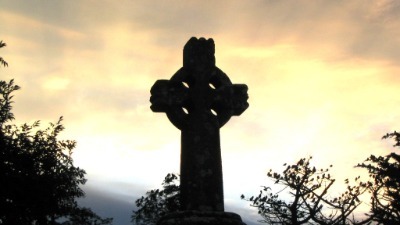Through the Storm
Epilogue - The Ancient Light
 The ‘Old Light’ lighthouse on Lundy was literally built on the very site on Beacon Hill where once a 2nd - 4th century Celtic Christian community had been. Sadly, very little by way of historic facts concerning the Church of this period is actually written down. But it was certainly in existence and highly effective in spreading the authentic Hebraically-rooted gospel throughout the Celtic fringes of the nation for the best part of 500 years prior to St Augustine’s arrival in Canterbury.
The ‘Old Light’ lighthouse on Lundy was literally built on the very site on Beacon Hill where once a 2nd - 4th century Celtic Christian community had been. Sadly, very little by way of historic facts concerning the Church of this period is actually written down. But it was certainly in existence and highly effective in spreading the authentic Hebraically-rooted gospel throughout the Celtic fringes of the nation for the best part of 500 years prior to St Augustine’s arrival in Canterbury.
The Celtic Church continued to exist in Britain beyond the Council of Whitby (664AD) but it gradually lost power as an increasingly Christianised society required a change of ministerial emphasis from an itinerant evangelistic model towards the pastoral one based on the parish system which the Roman model of Church supplied and which we still know today.
God used the Celtic remains at the Old Light on Lundy – especially one early grave that is said to be that of St Patrick’s grandfather Potitus – to direct us towards an exploration of the particular beliefs, practices and patterns of life in the British Church of the 2nd - 4th centuries. This was a time when Britain was still pagan, governed by an oppressive Roman empire and the native British Church persecuted.
These early believers did not live in large powerful medieval abbeys with their wealth, strict order and ritual. Rather, up to around a dozen individuals would gather together in a small home, in loose association, providing corporate reassurance, security and sometimes refuge for others.
Relationships were characterised by accountability, transparency and trust.
They lived off the land and slept in simple stone huts. A high value was placed on the kind of sincere friendship, open trust and strong fellowship-bond found amongst the biblical early Church. The lifestyle was uncomplicated and informal. The spiritual teacher was appointed solely because of his inspiring wisdom, holiness and other gifts. Relationships were characterised by accountability, transparency and trust.
While far from perfect, as all human groups are, with their own idiosyncrasies and problems to deal with, these underground communities became hidden centres of worship, teaching, prayer and discipleship. The Great Commission of Matthew 28:18-20 and Mark 16:15-18 was taken very seriously, which is why their humble itinerant lifestyle leaned towards a modelling of Jesus and the apostles.
I hope you will agree with me that digging down into the roots of our native British Church heritage reveals something of great value. These largely unknown but brave Celtic believers carried something in their spiritual D.N.A. which we need again today if the Light of Life is to shine powerfully in the Church as persecution grows.
Like us, the Celts lived in uncertain times - the Roman Empire was retreating and the whole fabric of society was uncertain and under threat. Just as today, the ordinary people at ground level were in need of rescue, as society as they knew it, began to crumble.
With all their imperfections, the Celts embodied a living Spirit-led organism, exhibited tremendous faith and saw God perform miracles.
With all their imperfections, the Celts embodied a living Spirit-led organism, exhibited tremendous faith and saw God perform miracles. They understood the spiritual realm as well as the natural, and they were serious, sober and obedient disciples of Jesus.
These believers were not ‘religious’ - that largely came to the church after Whitby – rather, they simply walked in a daily intimate relationship of covenant fellowship with God and one another. They brought spiritual awakening to whole geographical areas of the South West of England and South Wales. Little by little God used this movement which had begun underground to change society.
I find it fascinating that all of this Christian history was buried on the island of Lundy, where God took a group of us to consider what the nature and shape of Church for the future might be needed. It is definitely not about us becoming modern-day Celts, and it is essential that we do not over- romanticise their way.
Little by little God used this movement which had begun underground to change society.
Rather, we wish to learn from the positive features of their faith, and to walk as Jesus, Noah, Abraham, Moses and David walked, in covenant relationship with God. If we learn these lessons, we will, with God’s grace, be equipped to stand strong in God through the storms that lie ahead.
The following poem was written by Nicholas Szkiler at the end of our visit to Lundy in February 2019. It gives a fitting conclusion to our journey Through the Storm.
Lundy’s Ancient Light
Moonlight shadows on Lundy’s rocky shore;
Unchanged from days of saints who walked before.
The fire not seen by most who tread these paths,
Pilgrims dug for embers from the past.
And now a beacon blazes once again;
Wind of Spirit fans the holy flame,
The hidden light we’ve been allowed to find.
The Saviour’s Light to draw all humankind.
The deer, the lamb, the horse, their quiet gaze,
Witness of the few who came to praise.
We know where this began, though not where it ends;
The beacon light that lights these isles again.
Sarah Winbow, 21/08/2025